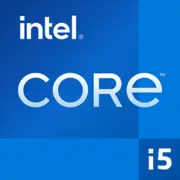Intel Core i5-14600K

Intel Core i5-14600K: A Comprehensive Review of the 2025 Processor
Raptor Lake Refresh Update for Gamers and Professionals
Key Features: Architecture and Performance
The Intel Core i5-14600K processor, released in late 2023, remains relevant in 2025 thanks to the balanced architecture of Raptor Lake Refresh.
- Manufacturing Process and Cores:
The chip is built on Intel 7 technology (equivalent to 10nm) and features 14 cores (6 Performance cores and 8 Efficient cores) with 20 threads. P-cores operate at a base frequency of 3.5 GHz with a turbo boost up to 5.3 GHz, while E-cores can reach up to 4.0 GHz.
- Cache and TDP:
The L3 cache is 24 MB, speeding up data processing in games and multi-threaded tasks. The TDP is stated at 125 W, but power consumption can reach up to 180 W when overclocked.
- Graphics:
There is no built-in GPU, so a discrete graphics card is required for system operation.
Key Features:
- Support for PCIe 5.0 for SSDs and GPUs.
- Intel Thread Director technologies for optimizing core workload.
- Overclocking capability (indicated by the "K" suffix).
Performance:
- In Geekbench 6, the processor scores 2861 points in single-core tests and 17974 points in multi-core tests, which is 8-10% higher than the i5-13600K.
- In games (for example, Cyberpunk 2077 or Alan Wake 2), the CPU demonstrates stable FPS when used with GPUs like the RTX 4070 Ti or RX 7800 XT.
Compatible Motherboards: Sockets and Chipsets
The processor uses the LGA 1700 socket, compatible with 600 and 700 series chipsets.
Recommended Chipsets:
- Z790: For enthusiasts. Supports overclocking, PCIe 5.0 x16, and up to 4 NVMe SSDs. Examples: ASUS ROG Strix Z790-E (around $320).
- B760: A budget option. No CPU overclocking, but PCIe 5.0 is available for graphics cards. Motherboards like the MSI B760 Tomahawk ($180) are suitable for most users.
- H770: Mid-range. Supports RAID and more SATA ports (e.g., Gigabyte H770 Aorus, $200).
Selection Tips:
- A BIOS update may be required for older 600 series boards.
- For PCIe 5.0 SSDs, choose boards with heatsinks on M.2 slots.
Supported Memory: DDR4 vs DDR5
The processor works with DDR4-3200 and DDR5-5600, but the choice depends on the motherboard:
- DDR5: Maximum performance. A 32GB DDR5-6000 kit (e.g., Corsair Vengeance) costs around $130-150.
- DDR4: Cost-effective with minimal losses. A 32GB DDR4-3600 kit (Crucial Ballistix) costs $80-100.
Tip: For gaming, the difference between DDR4 and DDR5 is minimal (2-5% FPS), but in rendering, DDR5 gains 10-15%.
Power Supply: Recommendations for Wattage
With a TDP of 125 W and peak consumption reaching 180 W (when overclocked), consider:
- Minimum: 650 W (for systems with an RTX 4060 level GPU).
- Optimal: 750-850 W (for RTX 4080 or RX 7900 XT).
Examples:
- Corsair RM750e (80 Plus Gold, $110).
- Be Quiet! Pure Power 12 M 850W ($130).
Important: Use power supplies with 80 Plus Gold/Platinum certification and a separate 8+4 pin cable for the CPU.
Pros and Cons of i5-14600K
Pros:
- High multi-threaded performance.
- Support for DDR5 and PCIe 5.0.
- Affordable price ($300-320 in 2025).
Cons:
- No integrated graphics.
- High power consumption when overclocked.
- AMD competitors are more efficient in power consumption.
Use Cases
- Gaming: Ideal for 1440p/4K with a powerful GPU. It delivers 90+ FPS at ultra settings in Hogwarts Legacy.
- Work Tasks: Video editing in DaVinci Resolve, 3D rendering in Blender.
- Streaming: No lag thanks to 20 threads (OBS + game).
Comparison with Competitors
- AMD Ryzen 5 7600X ($280):
- 6 cores/12 threads, less multi-threaded power.
- Better energy efficiency (TDP 105 W).
- Requires DDR5.
- Intel Core i5-14500 ($270):
- No overclocking, lower frequency (up to 5.0 GHz).
Conclusion: The i5-14600K excels in multi-threading but lags behind Ryzen in energy efficiency.
PC Building Tips
1. Cooling:
- A tower cooler (DeepCool AK620, $60) is sufficient for stock.
- For overclocking, consider a liquid cooling solution like the Arctic Liquid Freezer II 280 ($110).
2. Case: Minimum of 2 intake fans. Example - Lian Li Lancool 216 ($90).
3. BIOS: Check motherboard compatibility with the 14th generation before purchasing.
Conclusion: Who is the i5-14600K For?
This processor is a great choice for those looking for a balance between price and power:
- Gamers: Maximize FPS with a top-tier GPU.
- Content Creators: Fast rendering and multitasking.
- Enthusiasts: Overclocking potential and upgrade path to DDR5.
Alternatives: If integrated graphics are needed, consider the i5-14500 or AMD Ryzen 7 8700G.
In 2025, the i5-14600K remains an attractive option for building mid-range and high-end PCs, especially when using DDR4 for budget savings.
Basic
CPU Specifications
Memory Specifications
GPU Specifications
Benchmarks
Compared to Other CPU
Related CPU Comparisons
Share in social media
Or Link To Us
<a href="https://cputronic.com/cpu/intel-core-i5-14600k" target="_blank">Intel Core i5-14600K</a>




